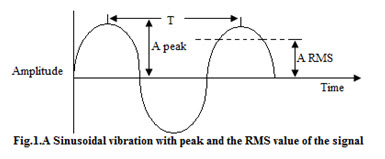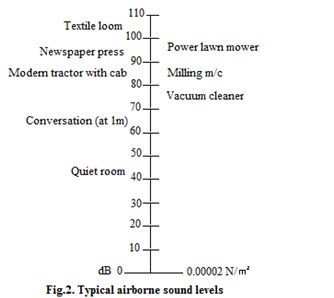Site pages
Current course
Participants
General
Module 1. Tractor Mechanics
Module 2. Traction
Module 3. Introduction to Transmission System
Module 4. Clutch System
Module 5. Gear Box
Module 6. Differential and Final drive
Module 7. Brakes
Module 8. Steering system
Module 9. Hydraulics
Module 10. Power Transmission
Module 11. Human Factors
Lesson 31 & 32. HUMAN FACTORS IN TRACTOR DESIGN
The design of modern tractor includes following human factors consideration:
- Riding comfort
- Visibility
- Location and arrangement of controls
- Ease of operating controls
- Design for thermal control, and
- Sound Control
These factors when properly incorporated in design, allow the operator to perform many complex with
- Efficiency
- Safety, and
- Minimum of fatigue
Operator Exposure to Environmental factors
Tractors are used under varied geographical and climatological conditions. Environmental factors to which operator is directly exposed are
- Temperature
- Humidity
- Wind
- Thermal radiation
- Dust, and
- Chemical
Design of a suitable enclosure for the tractor operator minimizes the effects of above factors. Table 1 defines comfort and bearable zones for humans.
Table1. Environmental Zones for Selected parameters
|
Environmental Parameter |
Comfort Zone |
Bearable Zone |
||
|
Lower Limit |
Upper Limit |
Lower Limit |
Upper Limit |
|
|
Temperature, °C |
18 |
24 |
-1 |
38 |
|
Humidity, %RH |
30 |
70 |
10 |
90 |
|
Ventilation, m3/min |
0.37 |
0.57 |
0.14 |
1.4 |
|
Ultraviolet radiation |
Unknown |
Unknown |
||
Thermal Comfort: Is defined as the state of mind that expresses satisfaction with the thermal environment.
The value of a roof on a tractor was investigated and found that the shade reduces the black bulb temperature 3.3° to 5.5°C on a hot summer day in Midwest conditions.
The thermodynamics process of hat exchange between man and hiss environment can be described by general heat balance equation:
S(Storage) = M(metabolism) – E(evaporation) ± R(radiation) ± C(connection) – W (work accomplished)
S is the amount of heat gained or lost. If the body is in a state of thermal balance, S becomes zero. Positive values of storage will cause the mean body temperature to rise; negative values will cause it to fall. It is most convenient to express the above terms as energy per unit of body surface (W/m2 or kcal/h-m2). The metabolic rate for a tractor driver will be in the range of 60 to 150 kcal/h-m2. Average body surface area of a man will be 2m2 resulting in 120-300 kcal/h.
Extension research has been devoted to develop indexes to evaluate thermal comfort. An empirical index- effective temperature (ET) was developed. Pre new ET scale is based on a simple model of human physiological response. Most individuals will be comfortable when the ET is between 23.9 and 26.7°C.
Operator Exposure to noise
It has been observed that 40 hours of exposure per week to second levels of 90 dBA or greater will produce permanent hearing loss. Noise-induced hearing loss does not occur in a sudden manner unless the noise exposure is extremely severe. Table 2 shows tha acceptable levels presently in existence.
Average noise levels for all tractors tested at Nebraska Tractor Test Lab without cab at 75% pull was 95.17 dB(A) at the operation’s site. Tractors tested with cabs averaged 91.4 dB(A). Tractors tested I 1975 with cabs at 75% pull averaged 88.04 dB(A) with the lowest reported being 80 dB(A). The average noise level for tractors without cabs at 75% pull averaged 96.0dB(A), with the lowest reported being 89.5dB(A).
Table 2. Occupational safety and health noise criteria.
|
Duration/day h |
Sound level dB(A) |
|
8 |
90 |
|
6 |
92 |
|
4 |
95 |
|
3 |
97 |
|
2 |
100 |
|
1 ½ |
102 |
|
1 |
105 |
|
1/2 |
110 |
|
¼ or less |
115 |
Acoustic noise is sound. The sound is characterized by frequency, amplitude and phase. The frequency range of the human ear extends from as low as 16 Hz to as high as 20,000 Hz. From a practical stand point, however, few adults can perceive sound above 11,000 Hz.
The simplest vibration is a pure tone which consists of a sinusoid with the frequency:
F = 1
T
Where, T = period, S

The magnitude is most commonly expressed as the RMS (root mean square) value because of its direct relation with the energy content of the signal in linear systems. For a simple, pure tone
Arms = 1 A peak
√2
Airborne sound is a variation in the normal atmospheric pressure. Most sound measuring instruments are calibrated to read RMS airborne sound pressures on a logarithmic scale in decibels. Sound pressure can be expressed as a sound pressure level (SPL) relative to a reference sound pressure for airborne sounds this reference sound pressure is 0.00002 N/m2.
Mathematically,
SPL = 20 log P dB
Po
and SPL = 20 log P
0.00002
Where,
SPL = Sound pressure level, decibels
P = measured RMS Sound pressure, N/m2
Po = reference sound pressure, N/m2
log = logarithm to the base 10
Fig.2. Shows some typical values for sound pressure levels. A doubling of sound pressure occurs with each increase of 6 dB.

General purpose sound measuring instruments are normally equipped with three frequency weighting scales A, B, and C. These scales approximate the ear’s response characteristics at different sound levels. Nebraska tractor test data are reported in decibels, using the A weightage scale and written as dB(A).
Operator exposure to vibration
Exposure of the human body to vibrations can result in biological, mechanical, physiological and psychological effects. Ride vibration intensities are normally positively correlated with ground speed and often become intolerable as speed is increased. A survey has revealed that about 76% of the tractor drivers had stomach complaints.
Care should, therefore, be taken in designing tractors and particularly tractor seat, to reduce vibration and shocks to a minimum by appropriate suspension and shock absorption and to arrange the tractor controls in a manner to insure a comfortable posture and minimum effort.
These effects are caused by low-frequency vertical vibration, that is, frequencies upto 20 Hz. This low-frequency vibration results in whole body excitation. Enggs (1973) observed the 4 to 8 Hz range as being critical. In this range resonance occurs in parts of the human body producing discomfort.
Low frequency vertical vibration is present during normal field operations. Amplitude of vibration is, in part, dependent on roughness of the field. The undamped natural frequencies of wheat tractors commonly lie in the 3 to 10 Hz range.
Higher frequency vibration (30 Hz and up) results in part-body vibration, although it is not important with regard to whole-body vibration, it is the source of foot and hand-arm excitation. The higher frequency vibrations can be present at the steering wheel, gear shift levers, control levers and floor panels.
Quilt frequently, vibration levels are expressed in decibels. A convenient reference level for vibration is 1 m/s2 RMS. It is mathematically expressed as
VAL = 20 log V/1 , dB ref. 1 m/s2
Where,
VAL = Vibration acceleration level, dB
V = measured RMS acceleration, m/s2
V = 1 (W2A)
√2
W = frequency of vibration, rad/s
A = peak amplitude, m
The operation – Machine Interface
Every time a person operates a tractor, the sensing, decision making and muscular powers of the operator are joined to an engineering system. The operator uses sound, sight and fuel to interpret inputs and to interface with the control-instrumentation components to achieve the desired output of the tractor. Human engineering data defining acceptable ranges for environmental factors, noise and vibration must be incorporated in the design to ensure operator safety and comfort.
Safety, comfort and convenience should be considered in the design, location and construction of the operator’s work place. The work place should be located on the machine so that visibility in the driving position is good without requiring the operator to work in an awkward, tiring position. Levers, pedals and instruments should be conveniently located and work place should fit both tall and short operations. In addition, the operator should be able to change his working position easily and the work area should be free of sharp edges and obstructions such as transmission cases.
Two functional conditions in design of the workplace for a tractor operator are visibility and clearance. Primary visibility or “ent the window observation” for a tractor requires provisions so that the operator can look in any direction. Near ground vision to the front and rear of the operator is important. Far vision in all directions is necessary. Secondary visibility is needed to monitor instruments or lights inside the workplace or cab.
Clearance at various levels is necessary to provide access to and from the workplace. Proper workplace dimensions in relation to the seat are important for ease in grasping and operating controls.
Sound control in operator enclosures
Reduced noise levels have in part been achieved by incorporating sound control measures in the operator enclosures. This design approach includes isolation mounts for the cab and suitable insulating materials for ceiling, walls, and floor.
Sound reaching the operator is structure-borne, airborne, or a combination of both. Structure-borne sound results from vibrations transmitted from the vehicle through the cab attaching points. Air-borne sound is transmitted through air and enters the operator area through holes or through the enclosure walls.
The floor of the cab is treated with a barrier material, normally polyvinyl chloride (PVC). A rubber material then onslays the warrier. Surface areas above the floor are treated with noise absorption materials that are effective I the 125 to 2000 Hz range. The predominant noise in tractor and other off-highway equipment is in the frequency range of 125 to 500 Hz.
Through design and development efforts, sound levels have been reduced to 80 dBA inside operator enclosures.
Thermal comfort in operator enclosures
Operator enclosure design must include cab pressurization, filtration, air movement, heating, cooling and window defrosting. These factors must be considered in order to provide clean air and proper velocity, temperature and air humidity for human thermal comfort. Design parameters to meet a wide range of climatic conditions are given in Table below.
Table. Design parameters for maintaining thermal environment in a tractor cab.
|
|
Parameter |
Rating or Capacity |
|
1 |
Heating |
8.2 KW at 66°C and water flow 11.4 h/min |
|
2 |
Cooling |
7.0 KW at 33°C and 60% relative humidity |
|
3 |
Air movement |
Three-speed blower rated at 0.235 m3/s at 50 Pa |
|
4 |
Cab pressurization |
50-100 Pa above outside of cab |
|
5 |
Fresh air filter |
1.92 m2 pleated paper, self cleaning |
Cab pressurization is necessary to prevent dust from entering the closure.